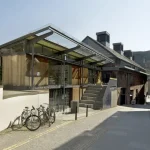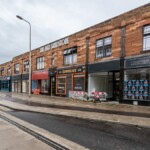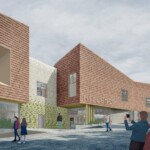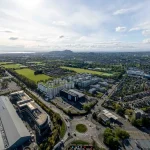Edinburgh, Architecture, Terry Levinthal, James Simpson Architect, Ian Begg
Big Debate : Conservation v Evolution
Edinburgh Development, Scotland
Conservation v Evolution Architecture Debate
Review by Isabelle Lomholt
So what’s New?
‘All together in the hot Hub’
“The Big Debate will feature some of Scotland’s leading figures from the architecture, arts, planning, conservation and construction worlds”.
RIAS @ The Hub, Castlehill, Edinburgh, 30.11.03
Speakers & Titles:
| Professor Charles McKean | False Oppositions |
| Murray Grigor | Historical Kitsch |
| James Simpson | Let us have real architecture! |
| Terry Levinthal | Nero fiddles… |
| Sir James Dunbar-Nasmith | The Big Debate of the phoney war? |
| Richard Emerson | Say hello to the Zeitgeist |
| Richard Murphy | Let’s not be beastly to Richard Emerson |
| Frank McDonald | The Construction of Dublin |
| Ian Begg | Vive la difference |
| Malcolm Fraser | Corduroy trousers, stainless steel bicycle clips |
All titles exaclty as per Programme
Great inniative! Excellent idea, planning and execution! Thankyou to the RIAS. A true pleasure hearing educated, mostly well-spoken, middle-aged (sorry Malcolm) men speak about conservation and approx. 2% evolution. The speakers were all men amongst whom there are no ‘spring chickens’. Was Dorothy Bell the token female, or am I on another agenda? The stuffiness was broken by occasional cheekiness and loud laughter, none louder than Richard Murphy’s when eloquent Mr Emerson was talking. Murphy, Wall and Fraser spoke clearly and delivered a clear message; as for the speaker from Dublin….
We arrived late and the second speaker – Mr Murray Grigor – had already taken the stage and was entertaining the audience with the talk he called “Historical Kitsch”; we were too late to get an idea, but a summary has been requested.
Mr James Simpson was next with the promising title “Let us have real architecture”, a promise he initially seemed to fulfill with a list of ‘we wants’. Mr Simpson was enthusiastic about ‘old architecture’ and spent a large proportion of his time on the podium defining conservation, quoting his old tutor: “conservation is maiking the most of what you have”. Mr simpson rounded off his talk by defining what he perceived as architecture and architects, including interesting figures on planning applicant ratios: “only 40% of planning applications are submitted by arvchitects…50% of architects are average or below”. We have a bleak future ahead of us with all this modern architecture.
Mr Terry Levinthal was on the podium as soon as Mr Simpson was off, no time to put your pen down, no time to lose momentum. His talk, ‘Nero fiddles….’ catapulted us into a firing survey of the audience. He wanted to know who were practising architects, and what percentage of those with their hands up had a copy of some conservation document in their offices (and I quote) “2%”, still had their hands up. he then showed a couple of slides documenting a survey which was peeformed on people who visited Doors Open Day 2001, trying to analyse their opinion on the built environment.
From there Mr Levinthal went on to Perth and how utterly depresssing its suburbs made him feel, followed by the many-tiem-covered subject of the banality of supermarkets. I immediately thought of the pleasant shopping environment of Camden’s streetscape Nicholas Grimshaw’s Sainsbury has provided us with (just look at BD’s Nov.2001 EH pull-out p.6 for MacCormac Jamieson Prichard’s crafted Ludlow Tesco to see the possibilities)
This day event seemed tto importnat to bring up quite serious points as these without following them up and making accessible conclusions.
A very entertaining Sir James Dunbar-Nasmith took the stage next and instantly made the audience laugh. We liked him, he was charming: “we need more architects on our planning panels….architects are the only people who are able to make aesthetic planning decsions”. One important pont sir Dunbar-Nasmith raised was that it should never be “do you like it?”, but “why do you like it?” Malcolm Fraser later picked up on this.
Richard Emerson called his talk ‘Say hello to the Zeitgeist’: it maybe should have been ‘Say hello to Richard Murphy’. Emerson felt most comfortable criticising his friends, so he talked about Richard a lot. We got some history about Mr Murphy and then some of his buildings were described. Hats off to Richard Murphy, but really it wasn’t him we had come to discuss, was it? Emerson raised some points about what the lottery has done for architecture about how buildings are only things, but they do have life and its sad when “they go”. Emerson stated: ‘Man kills the things he loves – Paris is being killed every day and being born every day”. How we got to Paris I don’t know.
Richard Murphy took the stage at high noon: he had called his talk “Let’s not be beastly to Richard Emerson”. Cut it short guys, this is not a debate about how great friends Richard and Richard are. Mr Murphy was enjoyable to listen to: he spoke with clarity and direction. The main points seemed to be difficulties with planning permissions in Edinburgh and a desire to knock down buildings (Queens Hall) which no longer served a purpose, rather than giving them new life, new purpose.
Frank McDonald‘s talk was next; he called it “the construction of Dublin”. Mr McDonald had great difficulties with his slides not being in the position they should be and sadly this was very disruptive: what should have been a leisurely cruise around Dublin became a bumpy ride. Mr McDonald did however finish off with concluding praise for a not-yet-built 120-metre-tall spike which is designed and planned for Dublin. Great iniative and innovation, they need a spike over there in Dublin!
After an hour in daylight and lunch we were back in the Hub, ready to hear more. This time Mr Ian Begg ceremoniously walked to the stage while what I guess was ancient tribal music was played. No reference was made to the music at this point, just like Mr Levinthal made no reference to his surveys of the audience. For a second I imagined Mr Begg breaking into a ritual tribal dance once he had reached the stgae; alas there was no dancing. However, Mr Begg’s talk of where we all come from, which is the only way we will find out where we are all going, and at last: “Conservation is our source for evolution”. Up until now there had been plenty about conservation, but evolution had scarcely been mentioned.
Mr Malcolm Fraser, the ultimate speaker of the day, called his talk ‘Corduroy trousers, stainless steel bicycle clips’. Mr Fraser talked about the Royal Infirmary – old versus new, pro’s but mainly con’s. Mr Fraser argued that by using 10% of the new Royal Infirmary budget on restoring the old Royal Infirmary, the latter could have been turned into a usable building.
One thing that did strike me as being very strange is that Edinburgh is going to have its main hospital out of town. Ill people, staff and visitors will have to travel quite a distance: this will prove inconvenient and is not exactly sustainable. Mr Fraser went on to making the point that buildings such as the Queen’s Hall, which is now too small to house the orchestra it is now home to, could be used for something else: there are plenty of organisations who would give their ‘right arm’ in order to gain premises like this.
With the two above examples of building history Mr Fraser marries conservation and evolution. Malcolm is not talking about things in ‘black and white’ it is not all about ‘tear down the old and put up the new’, but how we can integrate the modern with the still useful old. Mr Fraser concluded his well-formulated, thoughtful and ‘brief-fulfilling’ talk with the message: “Conservation means that we need to make a vigorous modern architecture”.
The audience applauded and the debate panel filled the seats along the table now on stage. This panel included: Dorothy Bell, Richard Emerson, Mike Galloway, Martin Hulse, Charles McKean, David Page, Charles Prosser, James Simpson, Ian Wall and Sebastian Tombs (chair). It seemed to me a great shame that only three of the speakers were represented on the panle, this to me posed a lack of continuity. The speakers whose opinions we had just become familiar with were now unavailable for questions and debate, but a whole new set of people with interesting points and likewise valuable messages were there to conclude.
Alternative Big Debate Review by Adrian Welch – Big Debate Hub
Future Scottish Architecture: Article from Irish Times – by Frank McDonald
Big Debate information from The Royal Incorporation of Architects in Scotland
Scottish Capital Conservation v Evolution
Conservation v Evolution Summary
If opportunities like this forum are misused as platforms for backslapping, we will never move forward. Most rejected the title of ‘Conservation v Evolution’ and continued with some sub-agenda, such as ‘Conservation & Evolution’ (Dunbar-Nasmith), or ‘Conservation is Evolution’ (Fraser).
Only Murray Grigor referred to the building we were in (a pock at the minimal lectern when he lost his notes) which surely asks many questions as to how to progress. The Hub, according to Tindall, represents a third way (see /Old Town): neither traditional nor modern. Why was Tindall not asked to speak? Why instead was the pasticheur Ian Begg asked to talk about contextualism of a type that seems universally unpopular? If this forum represented the way forward then Edinburgh must look forward to relegation. If Edinburgh wishes to rise in the world, then it needs a serious rethink.
All in all it was a very interesting and educational day, great initiative by John Pelan at the RIAS and all who helped. Sadly I believe that some of the speakers fell short in answering the debate’s title ‘Conservation v Evolution?’. Rarely did the speakers venture away from conservation and onto evolution: I wonder why.
Edinburgh Walking Tours : Architecture Walking Tours
Murray Grigor is a Scottish film-maker; he has produced films on the Scottish Parliament on Rennie Mackintosh and on Alexander Thomson.
Scottish Capital Building Designs
Scottish Capital Property Designs – recent architectural selection below:
Comments / photos for the Big Debate Edinburgh Architecture page welcome



